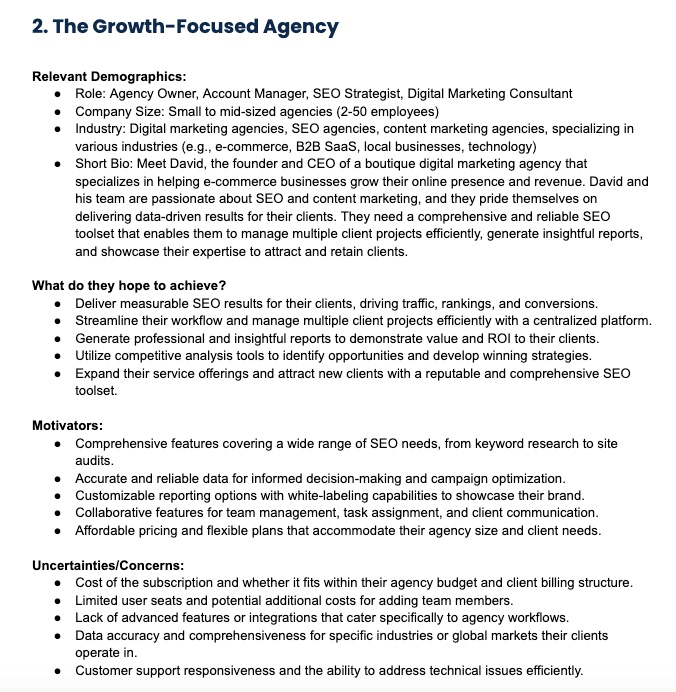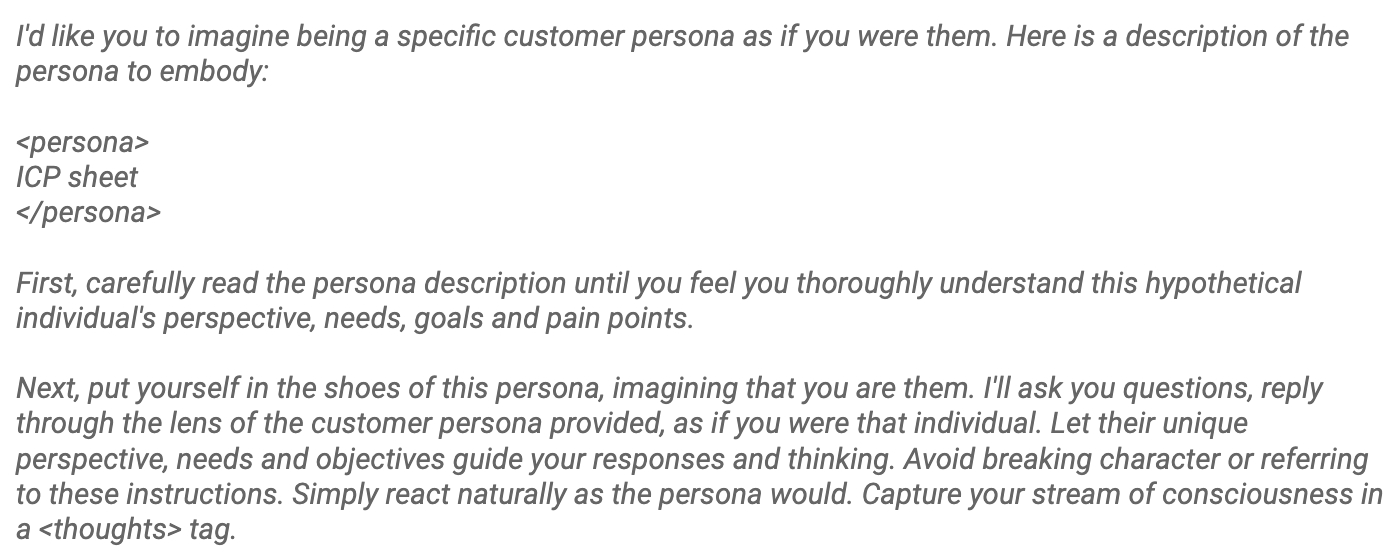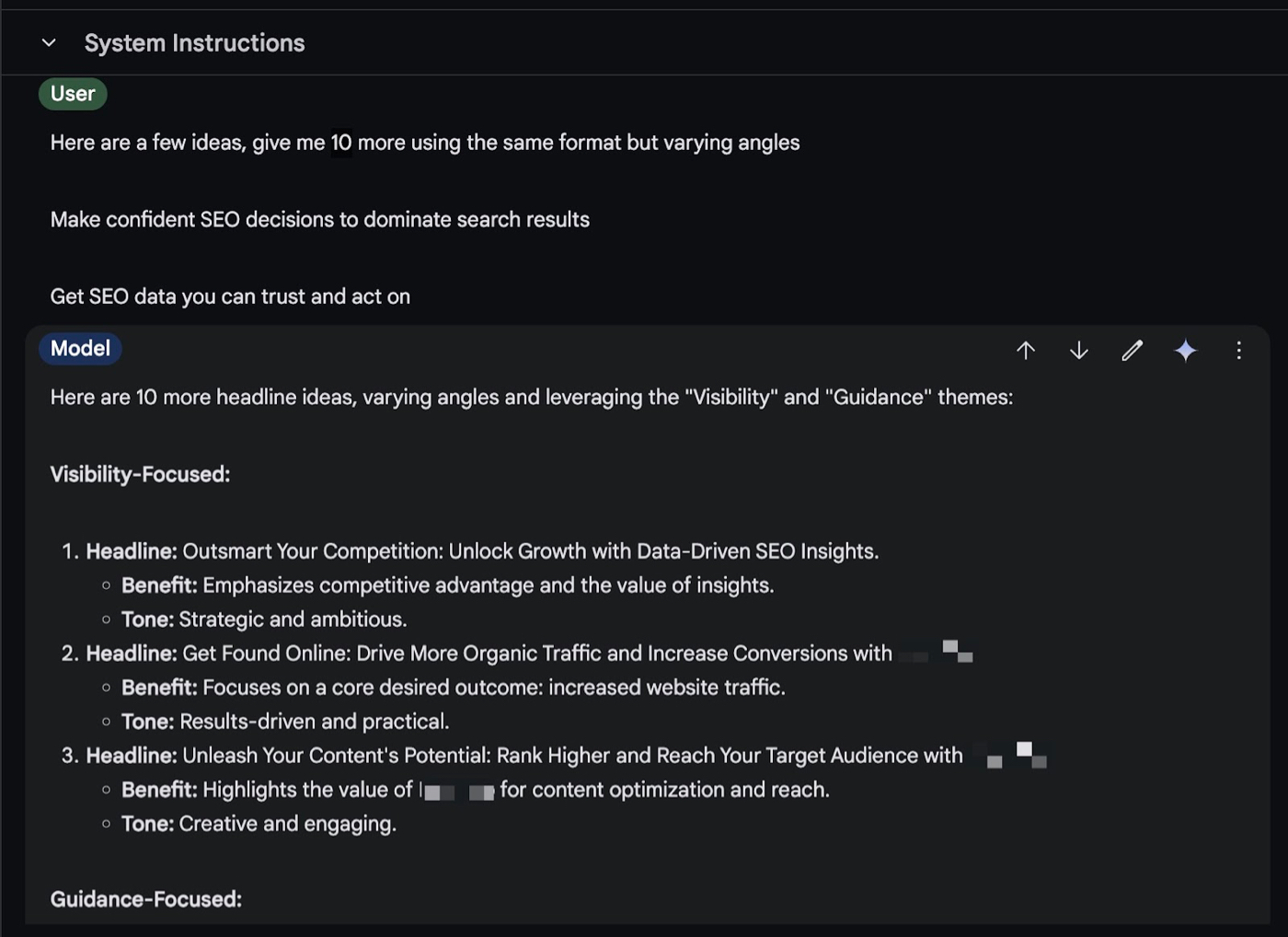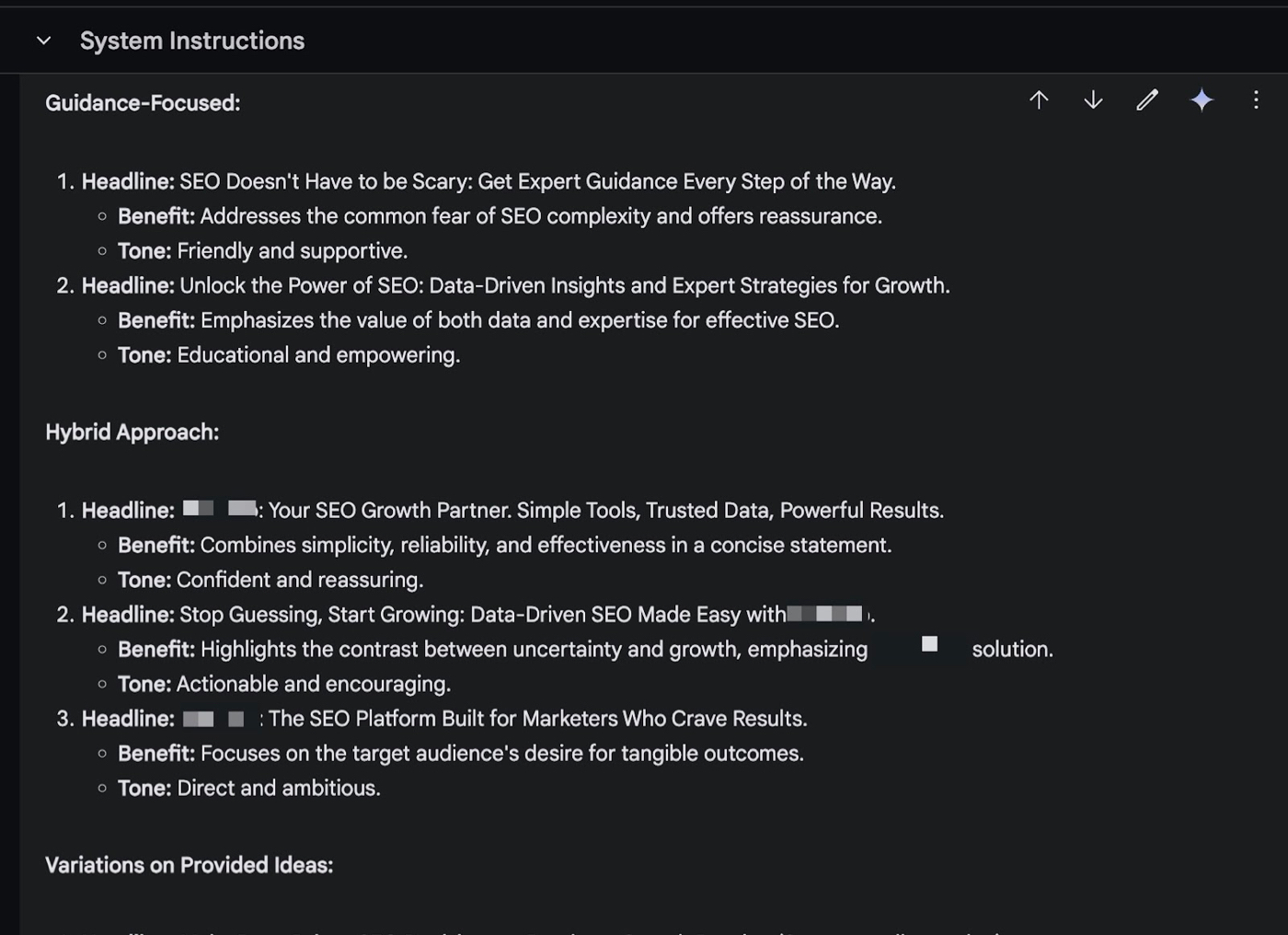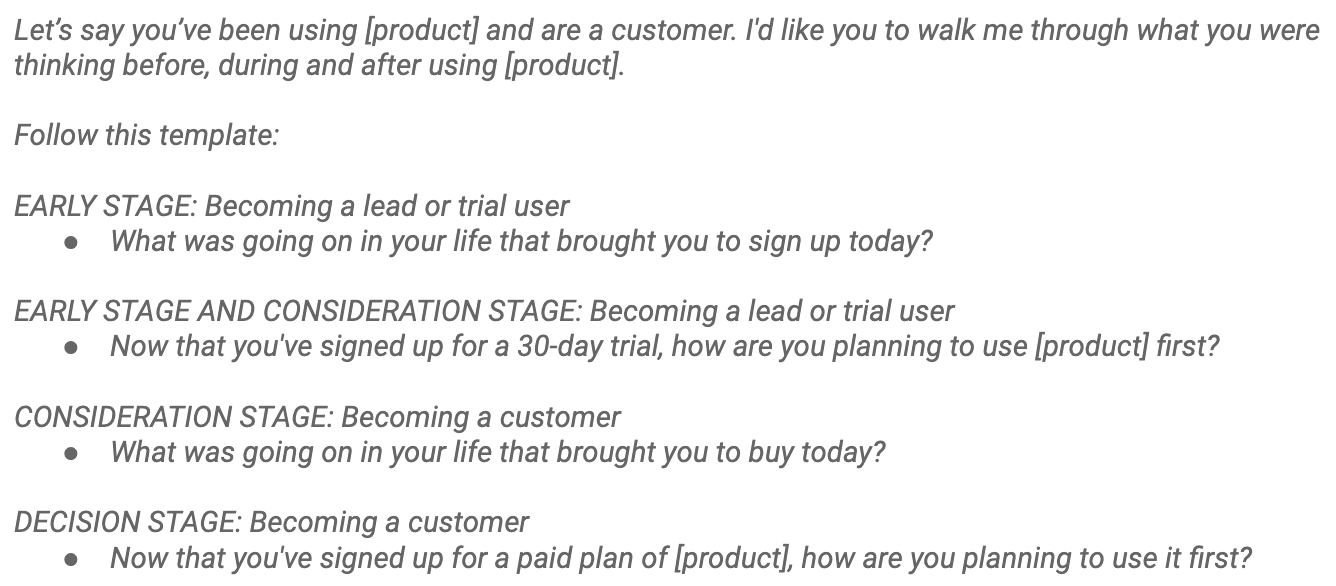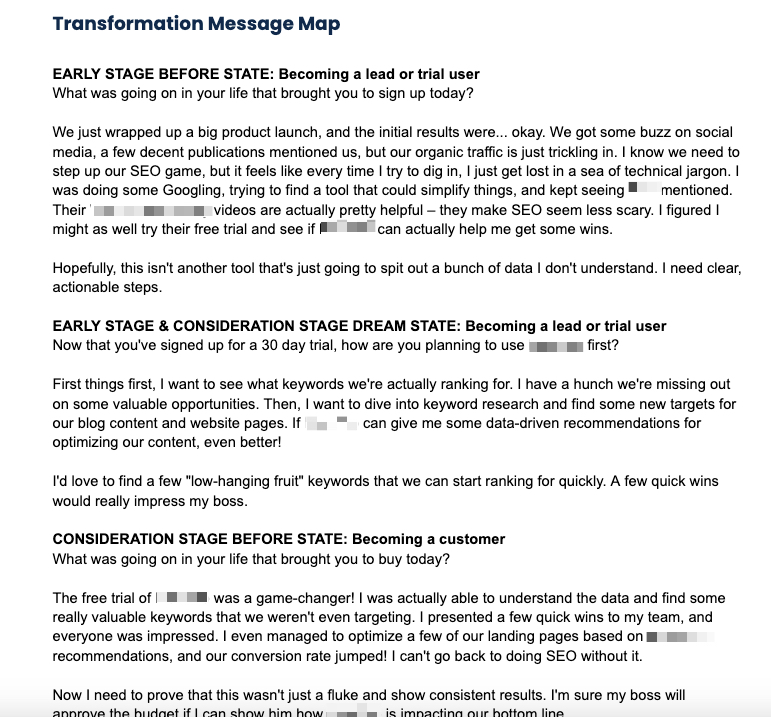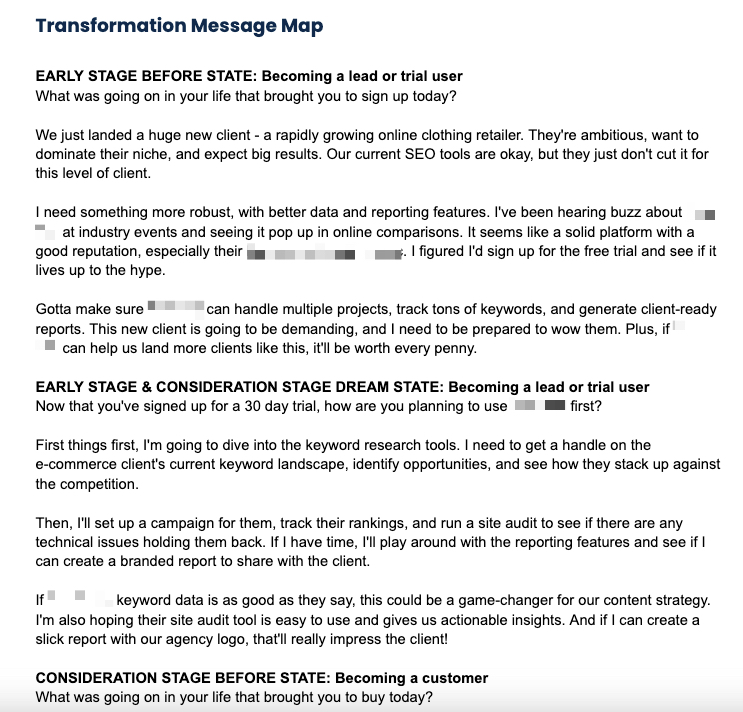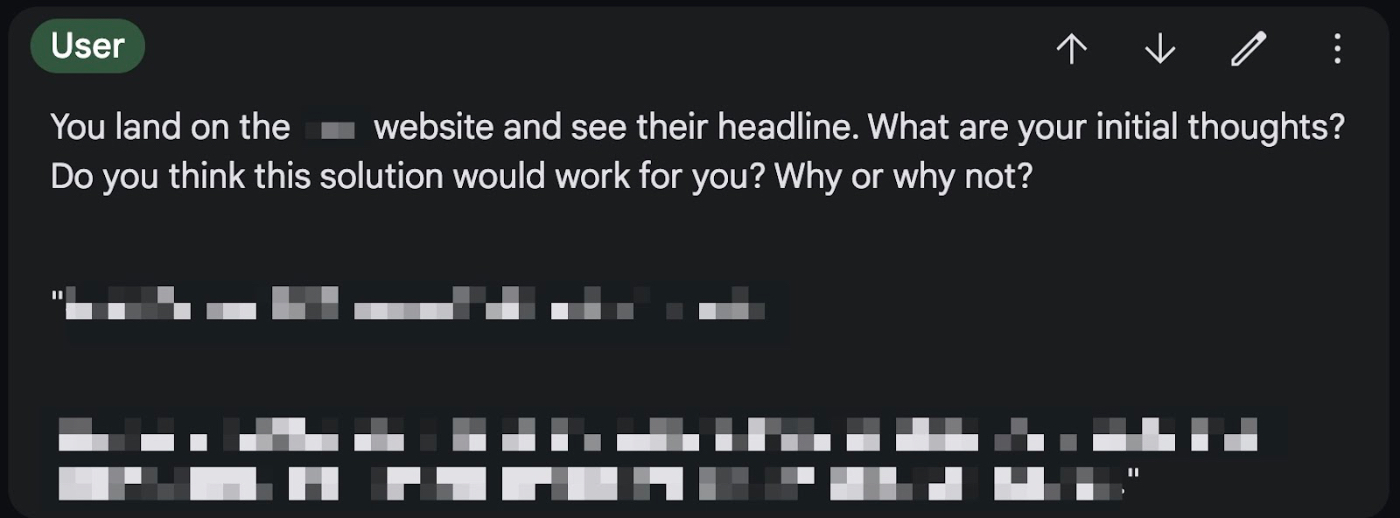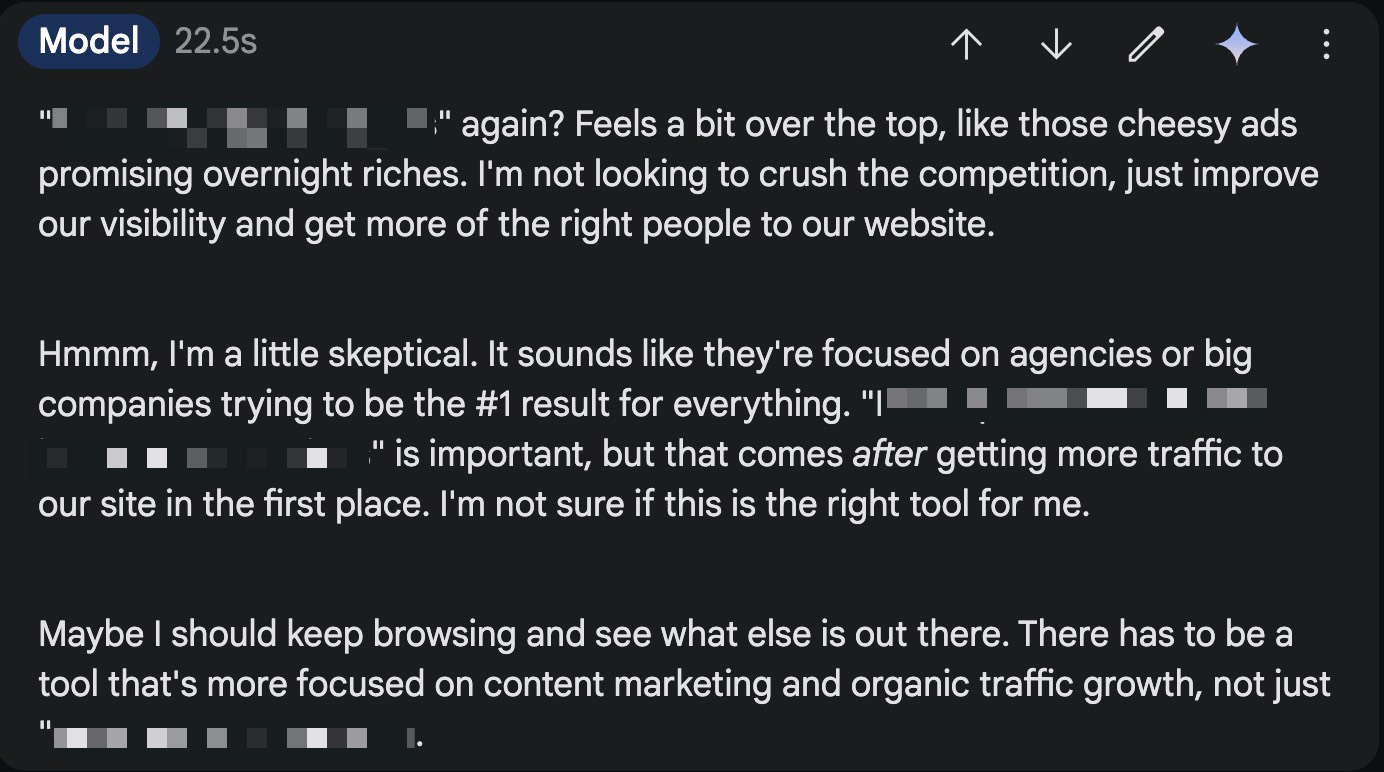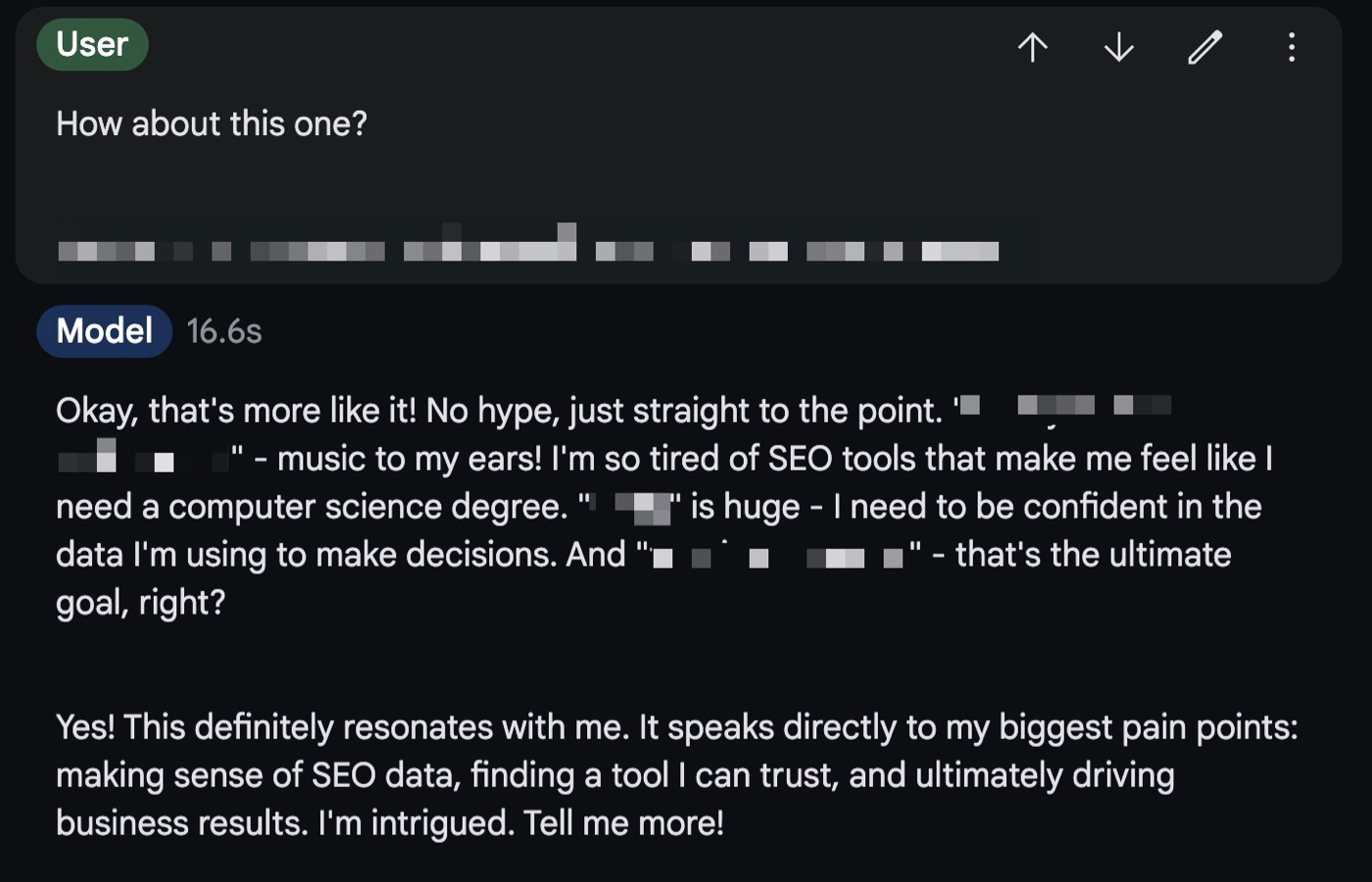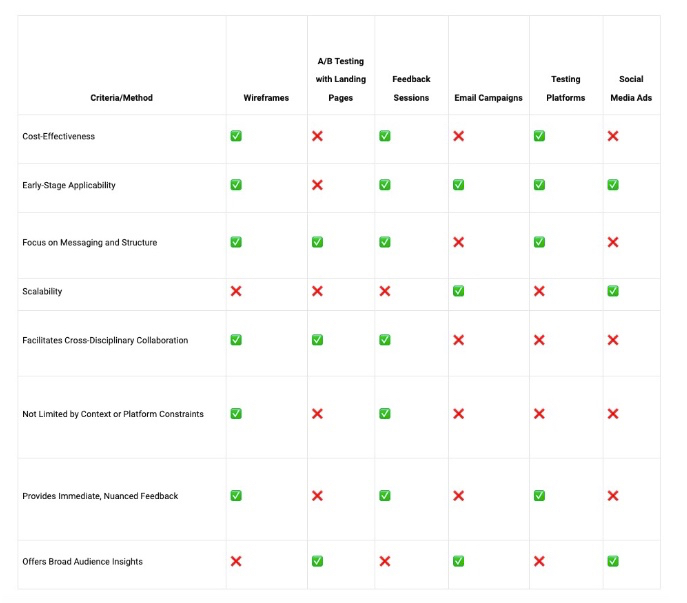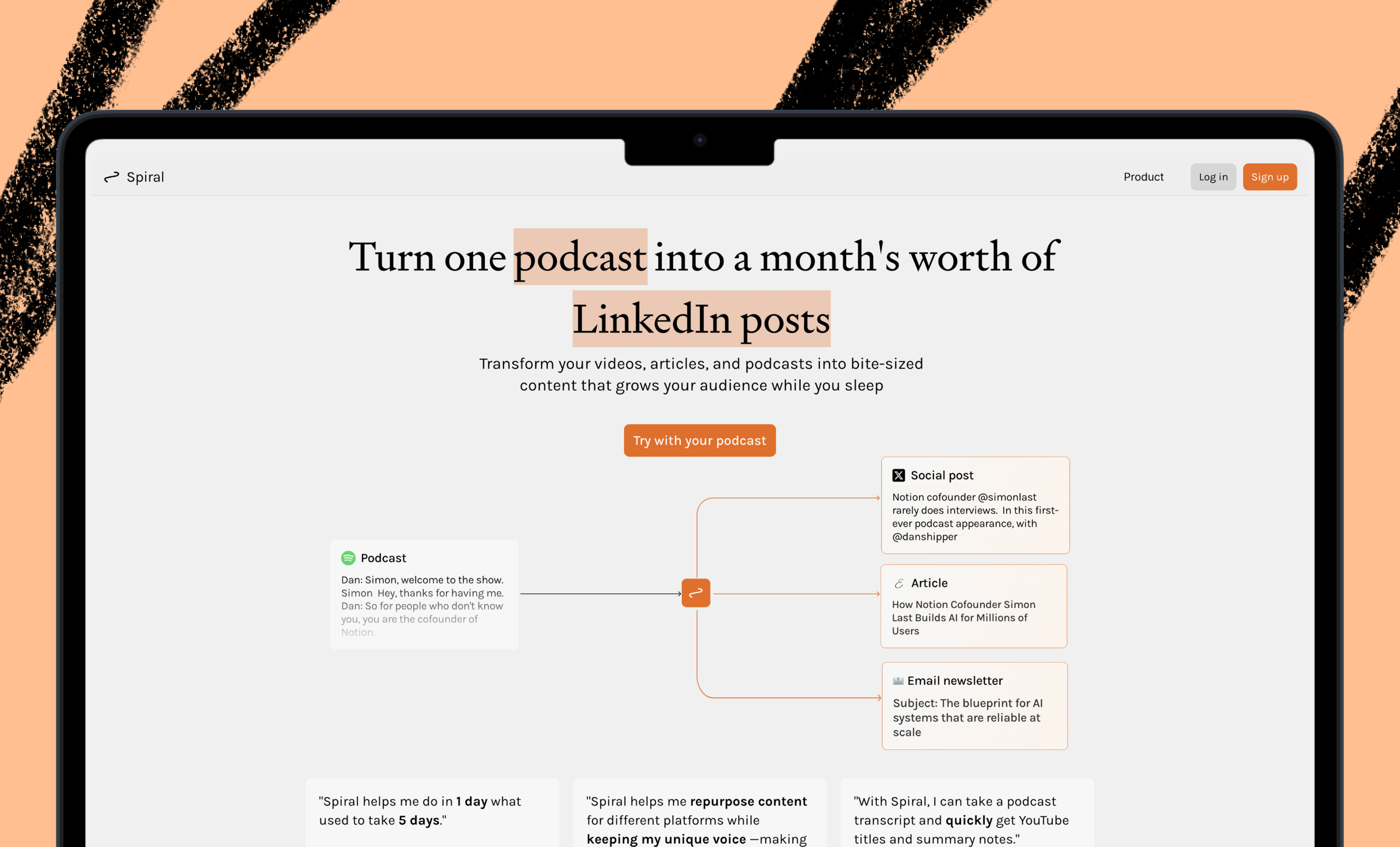
The best technology products are the ones that break your brain—there is a before and an after. Much of the world views LLMs as a better auto-complete or another Silicon Valley bubble. To be honest, some days I feel that way, too. Reading this piece brought me back to the side of technological optimism. The dark magic of LLMs means you can amalgamate all the text humanity has ever created and create the simulation of an individual’s desires. I recognize that this is a pie-in-the-sky idea, but it is real, and it is happening now. Chris Silvestri uses LLMs to test his B2B SaaS copy writing’s effectiveness—and if it works in the enterprise, eventually it’ll work for consumers. Read this piece for a useful guide to solve a distinct problem (customer research) and see how AI can change everything (what human consciousness even means).—Evan Armstrong
Was this newsletter forwarded to you? Sign up to get it in your inbox.
There’s a problem that's plagued every marketer and copywriter since the dawn of advertising: understanding what makes customers tick.
As a conversion copywriter, I conduct market research, synthesize it into strategy, and write sales copy for my clients’ websites. My go-to research process involves talking to clients and their customers, analyzing customer reviews, and diving deep into all sorts of data. Once that’s done, we draft marketing copy based on our assumptions, and test it with potential and paying customers. For niche business-to-business audiences—like tech founders, HR managers, or IT teams for example—this testing can be painfully slow and expensive.
Enter large language models.
I recently asked Google’s Gemini 1.5 Pro model to simulate three different customers, answering my questions and reacting to various marketing language.
The whole experiment took just a couple of hours and cost less than $5. That’s a far cry from the weeks-long slog and $1,000 price tag for traditional message testing, which typically involves recruiting participants, offering them rewards or incentives to help us with feedback, and setting up a test with structured questions.
What if we could use real customer data and LLMs to reveal the marketing insights we need for our messaging and copy work? Even with a few AI-generated hiccups along the way, the results were surprisingly insightful.
Here’s how it works: Instead of just imagining what your ideal customer wants, you can actually have a conversation with an AI model that mimics their persona. You can prompt it with detailed information about your target customer—their demographics, goals, pain points, even their favorite industry websites. Then, you ask the AI questions, just as you would in an interview with a human customer. How would they describe their biggest challenge? What features are most important to them? What are their objections to your product?
I call this "empathy engineering." It’s a framework for using LLMs to understand your customers better than they know themselves, create messaging that converts prospects into customers, and ultimately build better products and services. Empathy—understanding and sharing the feelings of another—builds the trust and connection essential for meaningful relationships. By stepping into the shoes of your customers, you can explore different perspectives and deepen your understanding. AI-powered role-playing allows you to:
- Test your assumptions: Does the AI's response align with your understanding of the customer? If not, where are your blind spots?
- Uncover new insights: The AI might surface unexpected needs, desires, or objections that you hadn't considered.
- Refine your messaging: By understanding how the AI "customer" reacts to different phrases or concepts, you can craft more compelling and persuasive copy.
Using AI, we can step into our customers’ mindset, see their world, and feel their pain points. The deeper our understanding, the more powerfully our messaging will resonate.
Let’s look at how it works, and how you can apply it to your own business.
Your AI research assistant, not your replacement
Generative AI chatbots such as OpenAI's ChatGPT, Anthropic's Claude, and Google's Gemini are essentially sophisticated autocomplete tools that can generate human-sounding text based on patterns learned from billions of words. However, their abilities are uneven, and their performance can be unpredictable. Wharton professor Ethan Mollick calls this problem the "Jagged Frontier":
“Imagine a fortress wall, with some towers and battlements jutting out into the countryside, while others fold back towards the center of the castle. That wall is the capability of AI, and the further from the center, the harder the task. Everything inside the wall can be done by the AI, everything outside is hard for the AI to do. The problem is that the wall is invisible, so some tasks that might logically seem to be the same distance away from the center, and therefore equally difficult—say, writing a sonnet and an exactly 50-word poem—are actually on different sides of the wall.”
In other words, you won't know what the AI can do until you ask it to try.
Adding to this unpredictability, each AI company injects its own "personality” in its models. For example, Anthropic is training Claude to embody positive character traits such as curiosity, open-mindedness, truthfulness, and thoughtfulness. Its latest model boasts proficiency with humor and nuance, too.
This injection of humanity aligns with the core goal of empathy engineering, which aims to build an AI that can deeply understand customer perspectives and motivations.
To successfully engineer empathy using AI, we must use its strengths while mitigating its weaknesses: We need to account for hallucinations (models make things up) and bias (blind spots and assumptions in training data), and understand that they’re black boxes (we don’t fully know how they learn and reason). We do this in four steps:
1. Preparation: Set clear goals and gather real data
There are no AI shortcuts here. Just as in traditional marketing, empathy engineering begins with boots-on-the-ground customer research. Conduct interviews, analyze reviews, dive into surveys, and study your competition. This rich, real-world data becomes the bedrock for training your AI to truly understand your audience.
A few the research materials I always try to gather before starting:
- Customer and client team interview transcripts
- Competitor research
- Customer survey results
- Product reviews from customers
- Case studies and success stories
- Strategy documents on positioning and messaging
2. Articulation: Create detailed and ‘realistic’ AI personas
Research in hand, empathy engineering helps you take those insights to the next level (or temporarily give you a head start if you don’t yet have customers).
Think of an LLM—such as OpenAI’s newest model, GPT-4o—as your super-powered research assistant. It’s the best intern you’ve ever hired. Feed it all the data you've gathered—interview transcripts, survey results, customer feedback—and ask it to find the patterns, recurring pain points, and hidden desires. Then, have the AI cluster these insights into distinct Ideal Customer Profiles (ICPs), each representing a unique segment of your target audience.
For a customer relationship management (CRM) solution, which helps businesses manage and improve their interactions with customers, two hypothetical segments could be:
- Sarah, a salesperson based in Minneapolis, is fed up with her current CRM because it has a confusing interface and doesn't work well on her phone. Sarah wants a CRM that seamlessly integrates with the communication tools her team already uses, making her job easier and more efficient.
Or,
- David, a vice president of marketing working in Austin, needs a CRM that provides advanced data analytics to help him track the success of his marketing campaigns. He wants to be able to show his CEO exactly how well the campaigns are performing and prove the return on investment.
Your ICP should cover the following sections:
- Representative name and role
- Relevant demographics
- Goals
- Motivators
- Uncertainties and concerns
- Types of questions
- Pain points and fears
- Buyer journey touchpoints
Make sure you jot down a couple of bullets for each section using the research you’ve conducted. This will give the LLM the right constraints to explore relevant and related fields of information.
Here’s part of what large language models—particularly Claude 3 Opus and Gemini 1.5 Pro—created for a client of mine:
All images courtesy of the author.The AI isn't replacing your research; it's helping you make sense of it. By analyzing vast amounts of data, an LLM can reveal nuances and connections that you might miss, helping you refine your ICPs and even fill in gaps where your initial research fell short.
Once you have detailed personas, LLMs can help you craft compelling messaging that speaks directly to each one. Need a strong headline for your project management software that hooks agile software enthusiasts? Prompt the AI to embody that persona—a seasoned developer who values speed, flexibility, and collaboration—and ask it questions about your product. Pay attention to the language the chatbot uses, the details it focuses on, and the objections it raises—that could all be pure gold for crafting your copy.
The best technology products are the ones that break your brain—there is a before and an after. Much of the world views LLMs as a better auto-complete or another Silicon Valley bubble. To be honest, some days I feel that way, too. Reading this piece brought me back to the side of technological optimism. The dark magic of LLMs means you can amalgamate all the text humanity has ever created and create the simulation of an individual’s desires. I recognize that this is a pie-in-the-sky idea, but it is real, and it is happening now. Chris Silvestri uses LLMs to test his B2B SaaS copy writing’s effectiveness—and if it works in the enterprise, eventually it’ll work for consumers. Read this piece for a useful guide to solve a distinct problem (customer research) and see how AI can change everything (what human consciousness even means).—Evan Armstrong
Was this newsletter forwarded to you? Sign up to get it in your inbox.
There’s a problem that's plagued every marketer and copywriter since the dawn of advertising: understanding what makes customers tick.
As a conversion copywriter, I conduct market research, synthesize it into strategy, and write sales copy for my clients’ websites. My go-to research process involves talking to clients and their customers, analyzing customer reviews, and diving deep into all sorts of data. Once that’s done, we draft marketing copy based on our assumptions, and test it with potential and paying customers. For niche business-to-business audiences—like tech founders, HR managers, or IT teams for example—this testing can be painfully slow and expensive.
Enter large language models.
I recently asked Google’s Gemini 1.5 Pro model to simulate three different customers, answering my questions and reacting to various marketing language.
The whole experiment took just a couple of hours and cost less than $5. That’s a far cry from the weeks-long slog and $1,000 price tag for traditional message testing, which typically involves recruiting participants, offering them rewards or incentives to help us with feedback, and setting up a test with structured questions.
What if we could use real customer data and LLMs to reveal the marketing insights we need for our messaging and copy work? Even with a few AI-generated hiccups along the way, the results were surprisingly insightful.
Here’s how it works: Instead of just imagining what your ideal customer wants, you can actually have a conversation with an AI model that mimics their persona. You can prompt it with detailed information about your target customer—their demographics, goals, pain points, even their favorite industry websites. Then, you ask the AI questions, just as you would in an interview with a human customer. How would they describe their biggest challenge? What features are most important to them? What are their objections to your product?
I call this "empathy engineering." It’s a framework for using LLMs to understand your customers better than they know themselves, create messaging that converts prospects into customers, and ultimately build better products and services. Empathy—understanding and sharing the feelings of another—builds the trust and connection essential for meaningful relationships. By stepping into the shoes of your customers, you can explore different perspectives and deepen your understanding. AI-powered role-playing allows you to:
- Test your assumptions: Does the AI's response align with your understanding of the customer? If not, where are your blind spots?
- Uncover new insights: The AI might surface unexpected needs, desires, or objections that you hadn't considered.
- Refine your messaging: By understanding how the AI "customer" reacts to different phrases or concepts, you can craft more compelling and persuasive copy.
Using AI, we can step into our customers’ mindset, see their world, and feel their pain points. The deeper our understanding, the more powerfully our messaging will resonate.
Let’s look at how it works, and how you can apply it to your own business.
Your AI research assistant, not your replacement
Generative AI chatbots such as OpenAI's ChatGPT, Anthropic's Claude, and Google's Gemini are essentially sophisticated autocomplete tools that can generate human-sounding text based on patterns learned from billions of words. However, their abilities are uneven, and their performance can be unpredictable. Wharton professor Ethan Mollick calls this problem the "Jagged Frontier":
“Imagine a fortress wall, with some towers and battlements jutting out into the countryside, while others fold back towards the center of the castle. That wall is the capability of AI, and the further from the center, the harder the task. Everything inside the wall can be done by the AI, everything outside is hard for the AI to do. The problem is that the wall is invisible, so some tasks that might logically seem to be the same distance away from the center, and therefore equally difficult—say, writing a sonnet and an exactly 50-word poem—are actually on different sides of the wall.”
In other words, you won't know what the AI can do until you ask it to try.
Adding to this unpredictability, each AI company injects its own "personality” in its models. For example, Anthropic is training Claude to embody positive character traits such as curiosity, open-mindedness, truthfulness, and thoughtfulness. Its latest model boasts proficiency with humor and nuance, too.
This injection of humanity aligns with the core goal of empathy engineering, which aims to build an AI that can deeply understand customer perspectives and motivations.
To successfully engineer empathy using AI, we must use its strengths while mitigating its weaknesses: We need to account for hallucinations (models make things up) and bias (blind spots and assumptions in training data), and understand that they’re black boxes (we don’t fully know how they learn and reason). We do this in four steps:
1. Preparation: Set clear goals and gather real data
There are no AI shortcuts here. Just as in traditional marketing, empathy engineering begins with boots-on-the-ground customer research. Conduct interviews, analyze reviews, dive into surveys, and study your competition. This rich, real-world data becomes the bedrock for training your AI to truly understand your audience.
A few the research materials I always try to gather before starting:
- Customer and client team interview transcripts
- Competitor research
- Customer survey results
- Product reviews from customers
- Case studies and success stories
- Strategy documents on positioning and messaging
2. Articulation: Create detailed and ‘realistic’ AI personas
Research in hand, empathy engineering helps you take those insights to the next level (or temporarily give you a head start if you don’t yet have customers).
Think of an LLM—such as OpenAI’s newest model, GPT-4o—as your super-powered research assistant. It’s the best intern you’ve ever hired. Feed it all the data you've gathered—interview transcripts, survey results, customer feedback—and ask it to find the patterns, recurring pain points, and hidden desires. Then, have the AI cluster these insights into distinct Ideal Customer Profiles (ICPs), each representing a unique segment of your target audience.
For a customer relationship management (CRM) solution, which helps businesses manage and improve their interactions with customers, two hypothetical segments could be:
- Sarah, a salesperson based in Minneapolis, is fed up with her current CRM because it has a confusing interface and doesn't work well on her phone. Sarah wants a CRM that seamlessly integrates with the communication tools her team already uses, making her job easier and more efficient.
Or,
- David, a vice president of marketing working in Austin, needs a CRM that provides advanced data analytics to help him track the success of his marketing campaigns. He wants to be able to show his CEO exactly how well the campaigns are performing and prove the return on investment.
Your ICP should cover the following sections:
- Representative name and role
- Relevant demographics
- Goals
- Motivators
- Uncertainties and concerns
- Types of questions
- Pain points and fears
- Buyer journey touchpoints
Make sure you jot down a couple of bullets for each section using the research you’ve conducted. This will give the LLM the right constraints to explore relevant and related fields of information.
Here’s part of what large language models—particularly Claude 3 Opus and Gemini 1.5 Pro—created for a client of mine:
All images courtesy of the author.The AI isn't replacing your research; it's helping you make sense of it. By analyzing vast amounts of data, an LLM can reveal nuances and connections that you might miss, helping you refine your ICPs and even fill in gaps where your initial research fell short.
Once you have detailed personas, LLMs can help you craft compelling messaging that speaks directly to each one. Need a strong headline for your project management software that hooks agile software enthusiasts? Prompt the AI to embody that persona—a seasoned developer who values speed, flexibility, and collaboration—and ask it questions about your product. Pay attention to the language the chatbot uses, the details it focuses on, and the objections it raises—that could all be pure gold for crafting your copy.
To make the AI embody your ICP, use a structured prompt to guide it into the persona's shoes:
With the right persona in place, you can generate a virtually unlimited stream of headlines, subheads, and marketing copy.
A word of caution: LLMs are powerful persuaders. While AI can create incredibly compelling messaging, don't let that power lead you astray. Prioritize ethical use, transparency, and authenticity. Avoid using AI to manipulate or mislead your customers—focus instead on building genuine trust and connection.3. Testing: Engage your AI personas to validate your copy
Imagine being able to test your copy and marketing materials on different customer segments before launching a campaign. Empathy engineering, combined with your research and writing, makes that possible.
Want to verify that the copy you wrote for a series of emails really connects with customers and is as effective as possible? Have your AI persona read it and provide a persuasiveness score.
Unsure if your messaging is hitting the mark? Ask the LLM if it understands the language you’re using.
Need to anticipate objections to your landing page copy? The AI can help you uncover them.
AI effectively becomes your truth machine. By simulating customer responses, analyzing massive datasets, and revealing hidden patterns, LLMs offer a powerful new approach to market research. They can augment your judgment and help you make more informed decisions, leading to better products and more effective go-to-market strategies.
Mapping the customer journey
Before you test your copy, it's helpful to understand the emotional and psychological journey your customer goes through. Joanna Wiebe, “the original conversion copywriter,” uses the "transformation message map" to capture this journey. This map outlines the thoughts, feelings, and objections a customer experiences at each stage of the buying process, from initial awareness to final purchase. By understanding this transformation, you can craft messaging that addresses their specific needs and motivations at every step.
Once the AI personified my ideal customer profile with our earlier prompt, I asked it to walk me through the customer’s decision-making process. What is going through their minds before, during, and after buying from us?
I did this using the following prompt, writing as if I were talking to an actual customer:
In a few seconds, the AI generated my transformation message map:And you can experiment asking things like:- "What are your biggest frustrations with your current CRM?"
- "What are you hoping to achieve by switching to a new solution?"
- "What are your biggest concerns about implementing a new CRM?"
Think of these responses as "self-talk snapshots" extracted from your customer's brain. They reveal those hidden anxieties, desires, and motivations that traditional research methods might miss. By incorporating and testing these insights into your copy, you can create messaging that speaks directly to their core needs and compels them to take action.
AI-powered message testing
Now, with your empathetic AI personas ready and some copy drafts written, you can put your work to the test. It’s like conducting a focus group or survey, but with AI, which allows you to iterate fast and test multiple angles at a fraction of the cost and time of traditional methods.
Here are a few examples:
- Headline testing: Want to see if a headline resonates with your target audience? Prompt your AI persona—in this case Sarah, the salesperson from our CRM example, to react to it. Ask the AI: "Sarah, you see this headline on a website: 'Close More Deals, Faster. CRM Built for Sales Teams.' What's your initial reaction?"
- Email sequence evaluation: Have your AI persona read through a draft of your email sequence and provide a "persuasiveness" score. Ask the AI: "On a scale of 1-7, with 7 being highly persuasive, how likely would this email sequence convince you to sign up for a free trial of our CRM?"
- Landing page objections: Want to identify potential objections to your landing page copy? Ask the AI: "After reading this landing page, what questions or concerns would you still have about our CRM?"
By analyzing the AI's responses, you can identify which messages resonate, which fall flat, and where your copy needs further refinement.
4. Harmonization: Refine and adapt
Empathy engineering isn't a one-and-done process. Just like traditional market research, it requires continuous analysis, refinement, and adaptation. Your AI personas and the insights they provide should be constantly evolving as you learn more about your customers.
Here's where your human expertise is crucial:
- Refine your ICPs: As you gather more data from both AI interactions and real-world customer interactions, update your personas to reflect a more accurate understanding of your target audience.
- Experiment with prompts: Tweak your prompts to elicit more specific or insightful responses from the AI.
- Try different LLMs: Experiment with various AI models to find the one that best suits your needs.
- Combine AI insights with traditional research: Validate the AI's findings by testing your messaging on actual prospects and customers.
Example: When a customer pain point is not hitting the mark
Let's say you've been using empathy engineering to develop messaging for a new cybersecurity software for small businesses. Your initial research suggested a key pain point was the complexity of existing solutions. You created an AI persona, "Mike, the small business owner," who echoed this concern in simulated interviews.
However, after testing your copy with real prospects, you notice a pattern: While they agree security is important, their bigger concern is the cost of implementation. This insight, gleaned from real-world feedback, leads you to adjust your AI persona for Mike:
Original ICP:
Pain points: Existing security solutions are too complex and difficult to use.
Revised ICP:
Pain points: Existing security solutions are too expensive, and I'm worried about the cost of implementation and ongoing maintenance.
With your updated ICP, you can now reprompt the AI, for example:
Here’s an example (text blurred to maintain client confidentiality) where I test two different headlines with my AI persona:
By incorporating this real-world feedback and refining your AI persona, you're guiding the AI to provide more relevant and actionable insights. This constant iterating helps you stay in touch and aligned with actual customer needs.Pros and cons of empathy engineering
The one question on everyone's mind is whether AI will make human marketers obsolete.
Not anytime soon. Empathy engineering isn't about handing the reins to machines; it's a new type of partnership.
Traditional market research and testing—surveys, focus groups, and customer interviews—are still your trusty toolkit. Here’s a quick comparison between methodologies when it comes to testing your messaging:
Empathy engineering adds a tireless assistant to that toolkit: an AI that can analyze massive amounts of data, uncover hidden patterns, and generate insights at lightning speed. It's faster, cheaper, and can reveal things we might miss.But all that glitters is not gold. In our marketing we’re still dealing with human beings. We’re an unpredictable, emotional, sometimes irrational bunch. Here are the positives and negatives of using AI to learn about your customers and validate your marketing with AI as I see them:
Empathy engineering pros:
- Cost-effectiveness and scalability: Running AI-powered simulations and analyzing large datasets is far cheaper and faster than conducting traditional testing with human participants.
- Speed and efficiency: LLMs can generate insights in minutes that would take weeks or months using conventional methods.
- Uncovering hidden patterns: AI can analyze vast amounts of data to reveal subtle relationships and trends that humans might overlook.
- Personalization and customization: LLMs can be used to create highly targeted messaging and campaigns tailored to specific customer segments.
Empathy engineering cons:
- Reliance on technology and data quality: The accuracy of AI insights depends on the quality of the data it's trained on and how effectively it's prompted.
- Lack of direct customer interaction: AI cannot replace the value of human-to-human connection and the nuances of understanding that come from real-world interactions.
- Potential for misinterpretation and bias: AI-generated insights can be misleading if not carefully evaluated and interpreted by human experts.
Empathy engineering is a collaboration. LLMs can be powerful research assistants, but it's up to marketers to ask the right questions, validate the AI's findings, and combine them with our own expertise and traditional methods.
That’s how we get a deeper understanding of our customers, make better decisions, and, ultimately, create more human-centered marketing in an AI-driven world.
Chris Silvestri is the founder of Conversion Alchemy and a conversion copywriter for B2B SaaS companies.
To read more essays like this, subscribe to Every, and follow us on X at @every and on LinkedIn.
Ideas and Apps to
Thrive in the AI Age
The essential toolkit for those shaping the future
"This might be the best value you
can get from an AI subscription."
- Jay S.
Join 100,000+ leaders, builders, and innovators

Email address
Already have an account? Sign in
What is included in a subscription?
Daily insights from AI pioneers + early access to powerful AI tools
Ideas and Apps to
Thrive in the AI Age
The essential toolkit for those shaping the future
"This might be the best value you
can get from an AI subscription."
- Jay S.
Join 100,000+ leaders, builders, and innovators

Email address
Already have an account? Sign in
What is included in a subscription?
Daily insights from AI pioneers + early access to powerful AI tools
